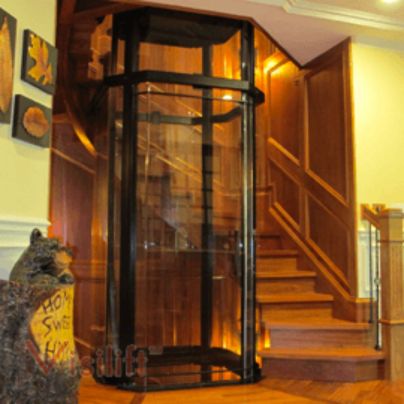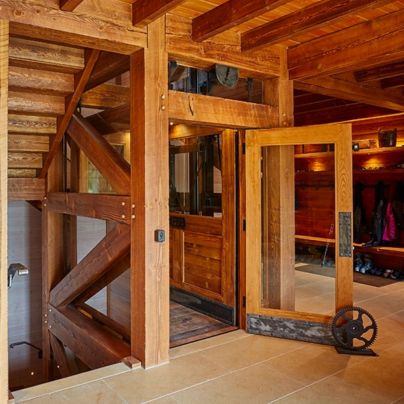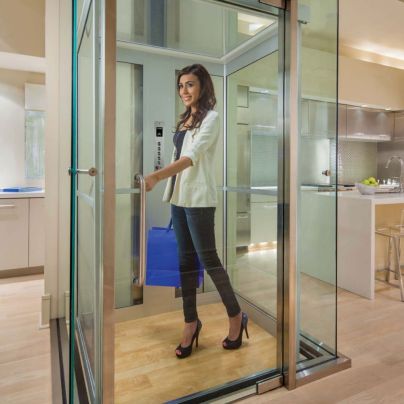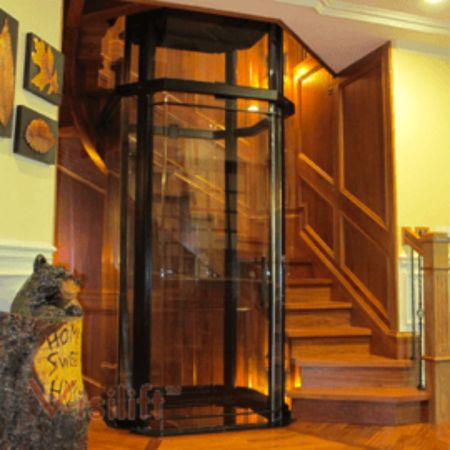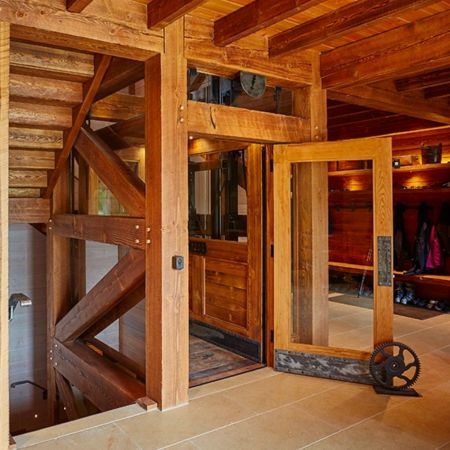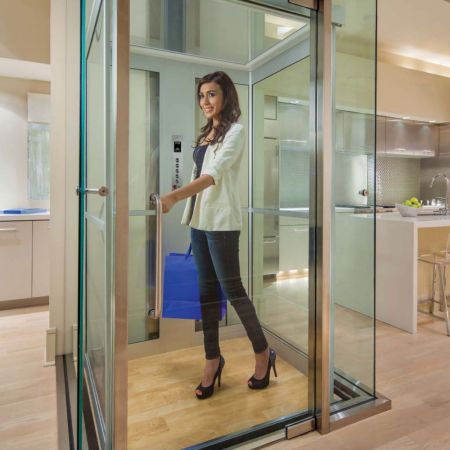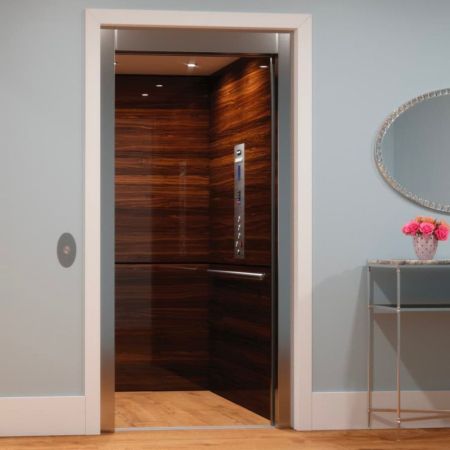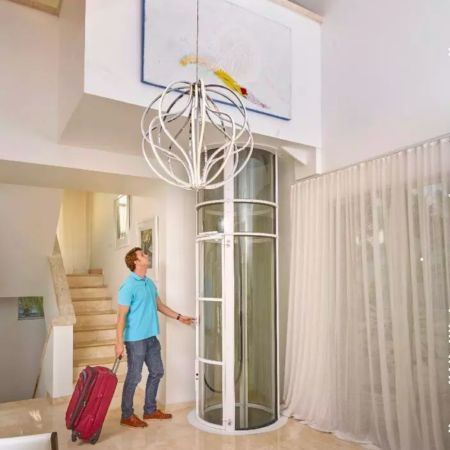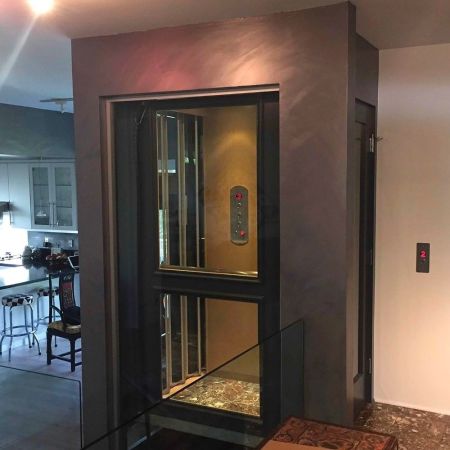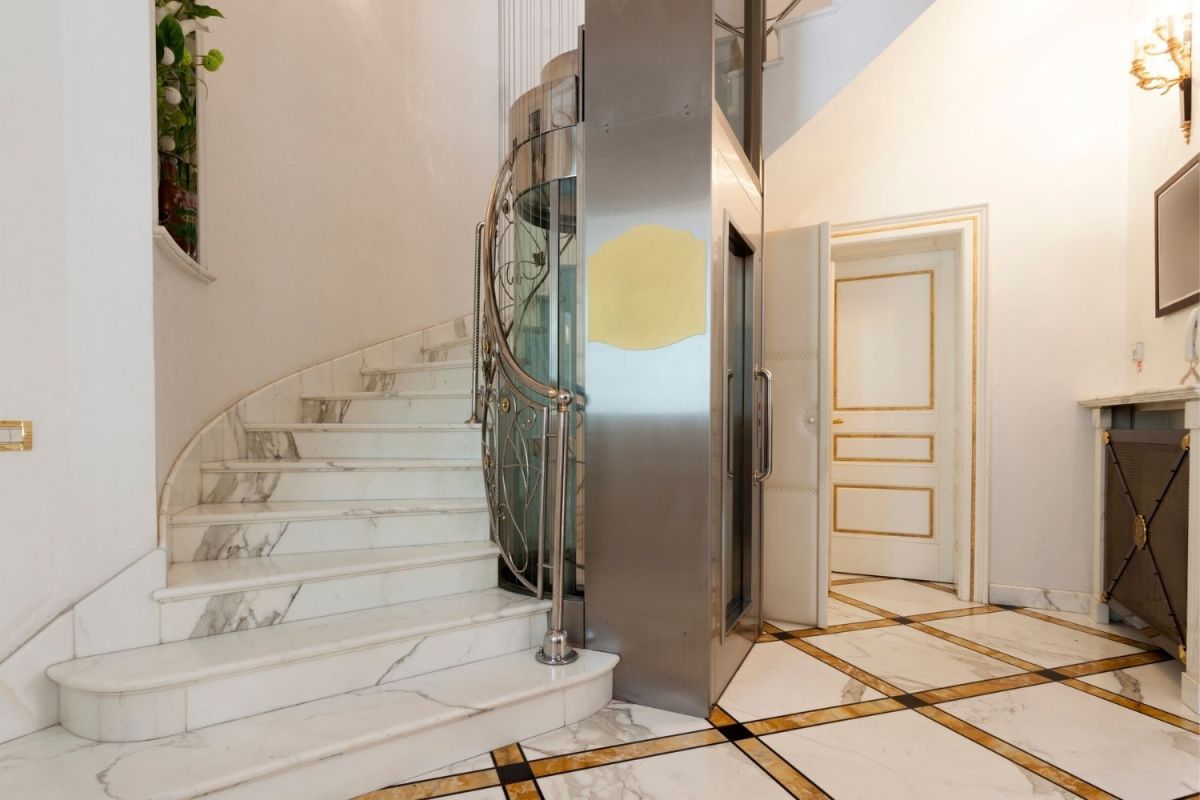
We may earn revenue from the products available on this page and participate in affiliate programs. Learn More ›
A modern home elevator can make a huge difference to the lives of those with mobility issues. It’s not just about aging; all kinds of health factors can impact the ability to move freely and easily. If stairs have become a barrier, a home elevator can restore accessibility and independence.
Modern home elevators come in an enormous variety of designs, and some can be built into surprisingly small spaces. The following list showcases some of the best home elevators for a variety of situations.
- BEST OVERALL: Nationwide Lifts
- BEST BANG FOR THE BUCK: AmeriGlide
- BEST INTERIOR OPTIONS: Inclinator
- BEST CAPACITIES: Savaria
- BEST VACUUM ELEVATORS: Pneumatic Vacuum Elevators
- BEST LUXURY: Symmetry Elevating Solutions
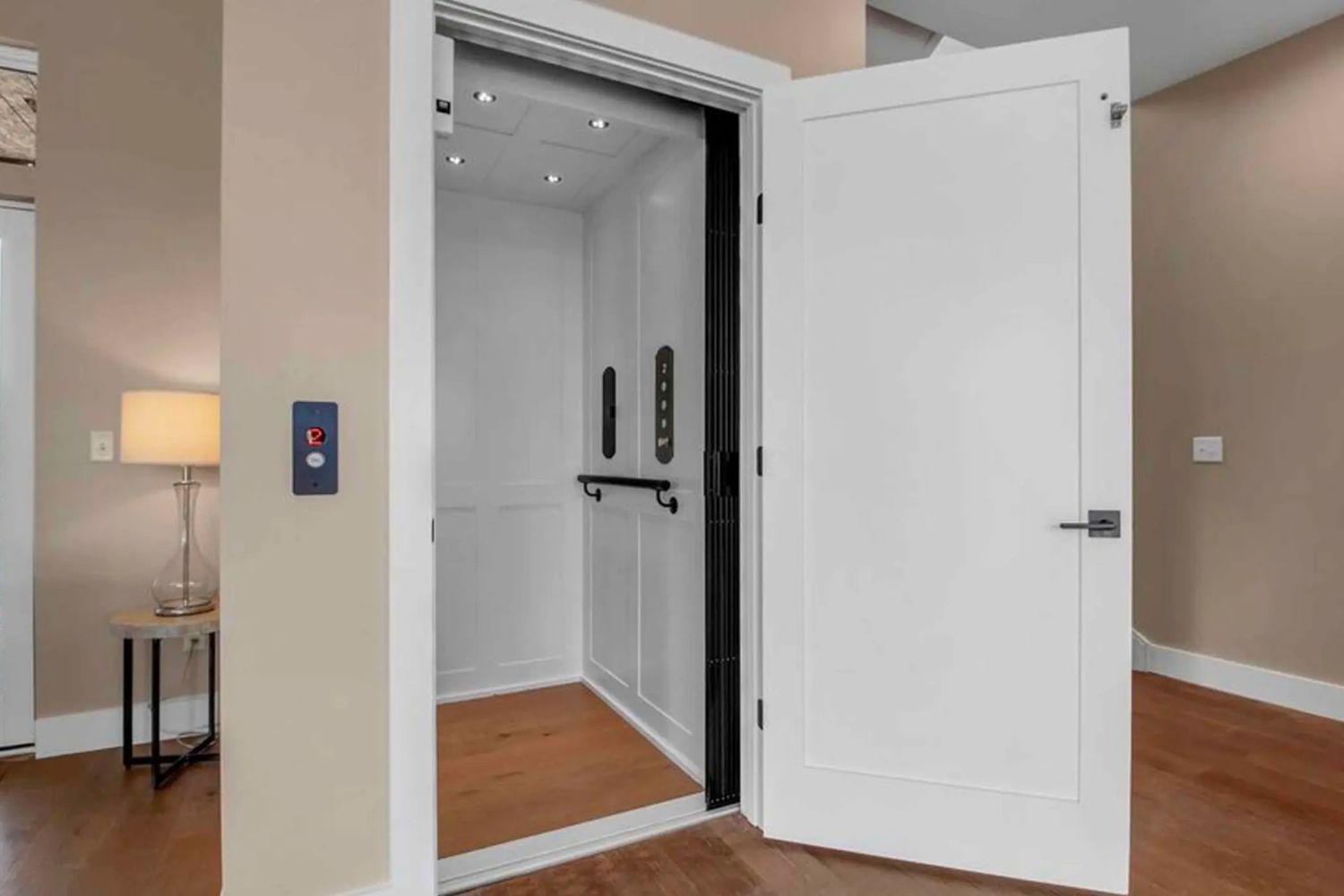
Types of Home Elevators
Elevators for home use are primarily differentiated by their drive mechanisms. This can impact the amount of space required, and the number of levels accessible, so it’s important to look at the options in some detail.
Traction (MRL)
Traction-drive elevators are also known as machine room-less (MRL) elevators because the gear for raising and lowering the cab is contained in what is known as a “hoistway” beside the elevator rather than requiring a separate room. Drive is provided by steel belts or cables around pulleys, with a counterweight to help balance passenger load.
Although a separate machine room isn’t required, a shallow pit often needs to be dug for foundations. A containing shaft will need to be built as well. Traction elevators can be quite powerful, capable of raising a cab up to five floors. Although it would be unfair to describe them as noisy, the machinery is in the same shaft as the elevator cab (though hidden from view), so the sound can be noticeable.
Cable Driven
Cable-driven home elevators are perhaps what most people typically picture when they think of an elevator. Cables wrap around winding drums at the top of the shaft, and the cab is balanced with counterweights in a similar fashion to traction elevators.
Cable-driven home elevators offer similar performance to traction elevators, with a five-floor lift possible. Much of the installation is similar, but provision needs to be made for a machine room at the top of the shaft. However, the winding gear of cable-driven elevators is easier to access, so maintenance costs are generally lower.
Chain Driven
Chain-drive is usually a variation on the traction-type home elevators, although in commercial installations it might replace the winding drum. In both cases, instead of a drum, a system of gears is used.
There are a number of advantages to chain-drive house elevators. Properly maintained, chains are more durable than cable and are quieter despite the mechanical complexity. Operation is frequently smoother as there is no “slack” to take up. Performance is equivalent to traction and cable models, though they are often more expensive.
Hydraulic
Hydraulic home elevators use a piston below the cab to raise and lower it. These are very powerful, capable of rising up to seven floors, and are often capable of supporting heavy loads. They usually operate very smoothly and quietly. Because the mechanism is mostly below the cab, they can often be used in rooms with lower ceiling heights than traction or cable models.
The drawbacks with hydraulic home elevators are that they require a substantial pit for the piston mechanism and a machine room for the pumping equipment. This usually needs to be on the ground level alongside the cab.
Pneumatic
Pneumatic elevators are not unlike a huge vacuum cleaner. They literally suck the cabin up a tube, and then a combination of gravity and reduced suction allows it to descend. They are often very energy efficient and can be extremely compact, yet they are still capable of a five-level rise.
Pneumatic elevators do not require a pit or machine room, but they do need more space overhead, which can sometimes cause challenges with installation. Despite the relatively simple mechanism, the airflow can create noticeable noise.
Shaftless
The term “shaftless home elevator” refers to the fact they don’t need to travel up and down inside an enclosed shaft as other models do. This often makes them the easiest type of home elevator to fit within an existing building because they require less space. Although they can be very compact, larger versions are available that can accommodate two people or a wheelchair.
Lift is provided either by an overhead winding mechanism (which would require a machine room) or geared drive fitted to the roof of the cab, which climbs vertical rails. For safety reasons, shaftless home elevators are only allowed to travel between two floors. They are capable of greater rise but would then need to be enclosed.
What to Consider When Choosing the Best Home Elevators
There are many reasons someone may want to add an elevator to the home. Home elevators for seniors are especially important for elderly persons who live in a 2- or 3-story home, while children and young adults with mobility issues could also benefit from adding a house elevator.
When choosing the right home elevator, consider who—and what—will be riding between floors. Those with wheelchairs, mobility aids, or even respiratory aids such as a portable oxygen tank will likely need a larger model, while a single adult who can stand upright on their own or with the use of a small cane may be fine with a small elevator.
Also consider whether the elevator will need to accommodate multiple people. Each of these factors can impact the amount of space required. While a home elevator can often be positioned near an existing staircase, this isn’t always the case. It’s important to consider user needs alongside more technical considerations, such as the type of drive mechanism used.
Design and Weight Rating
Design elements are important to how the elevator will fit within the style of your home. Cabs (or cabins) can be anything from sleek glass tubes to luxurious enclosures with hardwood paneling. They vary from minimalistic to opulent, and most manufacturers offer a variety of alternatives that are well worth exploring.
Every model of home elevator has a maximum weight rating. This varies from 350 pounds to 1,500 pounds. While the latter might seem excessive, there may be occasions where transporting multiple people and equipment is necessary. For example, an electric wheelchair can weigh up to 250 pounds; add four adults and the total is close to 1,000 pounds.
Safety
There is a national safety code for elevators developed by the American National Standards Institute (ANSI) and the American Society of Mechanical Engineers (ASME). The current version is ASME ANSI A17.1/CSA B44-2016, and private residential elevators are covered in section 5.3.
Safety features found in home elevators include:
- Automatic gate or door closing
- Door interlocks that cannot be released while the cab is moving
- Emergency brakes
- Battery backup in case of a power outage
- Alarms and intercoms
- Lighting and lit control panels
- Handrails
Many states have adopted ASME ANSI A17.1 as the standard for building codes associated with the installation of home elevators. Some have separate requirements, so it’s important to check with local authorities to be sure of compliance.
Installation and Maintenance
The amount of time required to install a home elevator will depend on the layout of the home, the number of floors the elevator will climb, and the type of elevator drive. Typically, shaftless and pneumatic elevators can be installed more quickly because there is usually less structural work required. Some manufacturers quote as little as 2 or 3 days, and most claim it will be under a week. That said, anyone who has had remodeling or building work done knows that there are sometimes unexpected circumstances. It may be worth speaking to the installer, and getting a “‘worst-case scenario.”
Home elevators are largely trouble-free, but an annual maintenance contract is recommended. This should also provide coverage in case of unexpected issues.
Our Top Picks
A great deal of customization is possible with most home elevators in terms of cab size and style, so rather than look at individual models, this guide focuses on home elevator brands. Each brand included in this list is well regarded in terms of elevator build quality and reliability.
Best Overall
Nationwide Lifts
While each home elevator brand on this list has its strengths, Nationwide Lifts manufactures both its own Freedom line as well serving as a supplier for several other leading brands. This makes it arguably the largest “one-stop shop” in the home elevator industry, with 11 different product groups available. They range from traditional to contemporary, with an almost endless array of customization options.
The Freedom Green model is notable for its eco-friendly principles. The interior of the cab is made entirely from recycled wood, and it claims energy savings of as much as 50 percent over conventional rivals. The Freedom Elite is its most powerful home elevator, capable of lifting 1,500 pounds.
Product Specs
- Types offered: Traction, cable, hydraulic, pneumatic, shaftless
- Max weight capacity: 1,500 pounds
- Price: $23,000 and up
Pros
- Unrivaled range
- 24/7 live support
- In-house financing available
Cons
- Maximum three levels on some models
- Finance rates may not be the most competitive
Best Bang for the Buck
AmeriGlide
AmeriGlide focuses on providing quality solutions at the budget end of the home elevator market. The products are manufactured in the U.S., so the company maintains close control of the whole process. Although the range is somewhat limited, and the cabs are all traditionally styled, there are numerous color and lighting options. All sizes are wheelchair-friendly. While a machine room is not necessary, a hoistway is required.
Aside from its competitive pricing, AmeriGlide also stands out as one of very few manufacturers who produce outdoor home elevators. These are aluminum-framed, weather-resistant designs that can be built into many homes but are particularly suited to beach or ranch-style properties that have exterior balconies.
Product Specs
- Types offered: Cable, MRL, hydraulic
- Max weight capacity: 950 pounds
- Price: $12,500 plus installation
Pros
- Transparent pricing (though not including installation)
- Exterior home elevators
- Standard models do not require machine room
Cons
- Modest range and designs
- Hoistway can add significant cost
Best Interior Options
Inclinator
Although Inclinator’s tried-and-tested drive mechanisms are much like many others, its approach to designing the most visual element of a home elevator, the cab, is almost bespoke in nature.
Several competitors go through a similar consultation process, but Inclinator excels in the details with an almost endless variety of possible combinations. Cabs can have clear acrylic or solid sides (the latter of which can be painted, veneered, or solid wood) and include five flooring options and nine ceiling options. Customers may also select lighting, handrails, and even variations on the control panel. Gates and doors provide an additional 18 alternatives. Those who want maximum control over home elevator appearance will certainly want to consider the Inclinator home elevator brand.
Product Specs
- Types offered: Cable, hydraulic
- Max weight capacity: 1,000 pounds
- Price: $30,000 and up
Pros
- Wide-ranging customization
- Comprehensive safety features
- Exterior installation possible
Cons
- Premium pricing
- Hoistway or machine room required
Best Capacities
Savaria
Savaria provides six distinct ranges and several drive options, among them a traction system that requires little more than a closet, rather than the typical machine room. There are also panoramic clear glass elevators, both round and octagonal. Most Savaria models can provide as many as six stops. There is also a two-stop “though-the-floor” model that has simplified installation and requires only marginally more space than the cab itself.
The maximum weight capacity of any Savaria model is 500 pounds, with many reaching 950 or 1,000 pounds. Several can transport up to 1,400 pounds. While one Nationwide Lifts model exceeds this, no other brand offers such capacities with such a variety of design styles.
Product Specs
- Types offered: Traction (MRL), geared chain, hydraulic, shaftless
- Max weight capacity: 1,400 pounds
- Price: $30,000 and up
Pros
- Stylish and unique designs
- Many capable of moving heavy loads
- Up to six stops possible
Cons
- Prices may vary depending on area
- Warranty conditions can be confusing
Best Vacuum Elevator
Pneumatic Vacuum Elevators
In some ways, selecting PVE as the best brand for pneumatic vacuum elevators is a bit of a cheat: it is currently the only company that uses this technology. However, the potential benefits here are such that it has a place in any best home elevators lineup.
While PVE offers five models, they are all basically the same, with size and weight capacity the main differences. The PVE30 is so called because it has an external diameter of just 30 inches. As a result, it will fit where no other type of elevator can. It still offers the ability to ascend five stops if necessary.
However, while the largest models can accommodate a wheelchair, the maximum internal diameter is 43.5 inches, so space is tight. The clear sides help, but claustrophobic passengers may not find them comfortable.
Product Specs
- Type offered: Vacuum
- Max weight capacity: 525 pounds
- Price: $30,000 and up
Pros
- Can fit in very modest homes
- Good energy efficiency
- Very low maintenance
Cons
- Wheelchairs can be a tight fit
- Noticeable noise
Best Luxury
Symmetry Elevating Solutions
Symmetry Elevating Solutions prides itself on quality solutions for any situation. In order to achieve this, it offers a wide variety of drive options, so it has something for every building type.
When it comes to designing the cab, the company offers a remarkably extensive feature set. The cab can be painted any color, or there are numerous species and styles of wood fittings. There are various control panel, phone, and lighting fixtures, and doors can wrap around the edge of the cab to offer a wider opening. Other styles offer automatic closure.
All of this is very impressive and should allow the home elevator to blend in with existing decor. However, the standout feature offered by Symmetry is the custom cab option. Its claim is, “If you can dream it, we can build it.”
Product Specs
- Types offered: Traction (MRL), cable, chain gear, hydraulic, shaftless
- Max weight capacity: 1,400 pounds
- Price: $20,000 and up
Pros
- Bespoke cab designs
- Up to seven stops
- Automatic doors option
Cons
- Likely to be expensive
Our Verdict
National Lifts takes the top spot for its extensive collection of high-quality home elevators that cater to just about every need. AmeriGlide has a much smaller range but still offers good choices at very competitive prices.
How We Chose the Best Home Elevators
On the rare occasions when installing and testing products ourselves is impractical, we rely on in-depth research carried out by the team and opinions gathered from industry specialists.
With high-ticket items like home elevators, manufacturer reputation is important. Each of the brands represented is highly regarded in terms of build quality and reliability. Cost is always a key element, and our selection offers something across a wide price range.
Of course safety is absolutely vital, and while the features may differ from one model to the next, as far as we are able to ascertain, each brand adheres to the current U.S. standards, whether fabricated in the U.S. or not.
FAQs
The above information was designed to give comprehensive information about the important aspects that should be considered when choosing a home elevator. We have also provided information on top brands to help with the selection process. During our research we found a few areas that understandably cause concern, so we have provided answers below.
Q. How reliable are home elevators?
They are usually extremely reliable, though adhering to an approved maintenance schedule is important.
Q. How much does it cost to put an elevator in a 2-story house?
It is difficult to say without a proper survey. However, research shows residential elevator cost to bearound $20,000 to $40,000 for installation. We have a more detailed look at home elevator costs in this article.
Q. Do home elevators get stuck?
It is very rare, but a power outage could cause a temporary halt. Battery backup is usually an option, allowing safe return to ground level.
Q. What happens if you get stuck in a home elevator?
Home elevators can be fitted with numerous call features that can alert people within the home or can connect with outside services. These provide valuable backup if the person in the elevator is not carrying their cell phone.
Q. How fast do home elevators move?
Most are somewhere between 20 and 40 feet per minute. In real terms, it means travel takes around 10 to 15 seconds per floor, depending on ceiling height.
